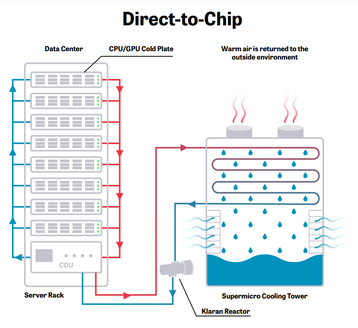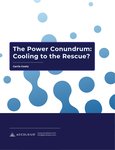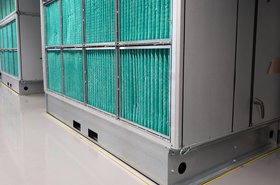As manufacturing organizations adopt artificial intelligence (AI) to power advanced analytics and automated decision-making, more efficient cooling techniques in data centers are required. As processing power grows, so does total energy loss, which increases the operating temperature in the racks. This has shifted the focus on effective, energy-efficient heat management to improve overall system efficiency.
To cope with the increased heat, data centers are replacing and enhancing traditional cooling systems that rely on air-cooled racks with liquid-cooled approaches, which can be anywhere from 50 to 1000 times more efficient.
Methods for active cooling and typical flow rate within the system
Long proven for mainframe and gaming applications, liquid cooling is expanding to protect rack-mounted servers in data centers worldwide. Some liquid cooling systems can reduce energy costs by up to 40 percent, reduce data center noise by 55 percent, and reduce electricity infrastructure costs by 89 percent.
The flow rate of water in an AI data center can vary widely based on the cooling system design, the size of the data center, the heat load generated by the servers, and the efficiency of the cooling technologies used.
- Cooling tower systems: For large data centers, cooling towers are commonly used to dissipate heat. The flow rate for water in these systems can range from hundreds to thousands of gallons per minute (GPM). A typical large data center might require flow rates in the range of 500 to 5,000 GPM or more, depending on the scale of operations and the local climate.
- Chilled water systems: Chilled water systems circulate water through heat exchangers to cool the air which is then used to cool the servers. Flow rates in these systems can also vary but might be in the range of 1,000 to 10,000 GPM for large data centers.
- Direct liquid cooling (DLC) systems: Some data centers use direct liquid cooling systems where water (or another coolant) is circulated directly to the server components. Flow rates here might be lower compared to cooling towers, often ranging from 10 to 100 GPM per cooling unit or server rack.
However, liquid cooling can also introduce some maintenance challenges to ensure this efficiency. A primary factor that can impact the efficiency of liquid cooling systems is biofilm growth on cold plates. Biofilms, communities of microorganisms that attach to solid surfaces, are common in reservoirs or circulation tanks where water can be heated.
The impact of biofouling on water efficiency
Water has excellent thermal conductivity and availability. However, it is also susceptible to microbial contamination, particularly as it carries the heat from the racks to the recirculation and cooling tanks. If water contains organic matter or is exposed to environmental contaminants, it can become a breeding ground for bacteria and algae. These microorganisms can form biofilms on the surfaces of the cooling system, further reducing heat transfer efficiency and leading to blockages.
In the case of direct liquid cooling systems, water quality becomes even more critical. Water used in this cooling method can contain impurities such as minerals, particles, and biological contaminants. These impurities can lead to several issues, including corrosion, clogging, and biological growth within the cooling system. Such problems can compromise the efficiency of the cooling process, increase maintenance costs, and even lead to hardware failures.
As water is cycled throughout the system, the chance of biofilms developing and reducing the overall efficiency of the system increases. Adding ultraviolet (UV) disinfection to the recirculation cycle allows these systems to maintain a level of water treatment that ensures optimal performance.
How UV disinfection works
Light in the germicidal ultraviolet (UVC) wavelengths, from 250 to 280 nanometers (nm), deactivates bacteria, viruses, and other microbes by destroying the genetic information inside the DNA. Deactivating these microbes prevents the formation of a biofilm matrix—which ultimately leads to biofouling. UVC irradiation offers a better method for biofilm prevention options as it is non-chemical and can be tailored to maintain a specific water quality level. This is a common treatment solution for drinking water—both at the centralized municipal level as well as at the point of use.
UVC LED-based solutions present an ideal solution to maintain water quality in these active cooling systems. As a solid-state light source, UVC LEDs can be operated with a duty cycle to maximize disinfection while optimizing power consumption and lifetime.
The amount of UVC radiation needed to meet a disinfection performance level is referred to as the required UV dose. The dose required to treat untreated water will be significantly higher than the dose required to maintain a level of disinfection in water post-treatment. Additionally, while continuous exposure is used in the treatment of flowing water, albeit on demand in UVC LED-based systems, studies have shown that pulsed UV can be more effective at controlling biofilms. This means that LED-based systems could deliver reliable, consistent water treatment for years with minimal impact on power consumption and maintenance costs.
Liquid cooling, both direct and indirect, is not simply a passing fad since its advantages have become more compelling with each generation of IT equipment. As a result, facility managers, data center managers, and thermal engineers are recognizing the merits of liquid cooling and there is a growing trend in its application to the IT environment.





